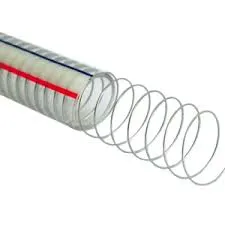flexible plastic hose sizes
Understanding Flexible Plastic Hose Sizes A Comprehensive Overview
Flexible plastic hoses are ubiquitous in various industries, from agriculture to manufacturing, automotive to food and beverage, due to their versatility and resilience. When selecting the right flexible plastic hose for a specific application, understanding the different sizes available and their optimal uses is crucial.
1. Common Sizes and Dimensions
Flexible plastic hoses come in a wide range of sizes, typically measured in inner diameter (ID) and outer diameter (OD). The inner diameter is especially critical as it determines the flow rate of fluids or gases that can pass through the hose. Common sizes include
- 1/4 inch (6.35 mm) Often used for light-duty applications, such as in aquariums or small watering systems. - 1/2 inch (12.7 mm) Widely used for garden hoses and low-pressure systems, providing a balance between flexibility and flow capacity. - 3/4 inch (19.05 mm) Suitable for medium-duty tasks, like irrigation and pressure washing. - 1 inch (25.4 mm) Ideal for industrial applications that require higher flow rates, such as in construction and heavy-duty farming equipment.
Larger hoses, such as those measuring 2 inches (50.8 mm) or more, are typically utilized in commercial or industrial settings, where high volumes of material need to be moved quickly.
The choice of material is pivotal not only for the hose’s durability but also for its suitability for specific applications. Flexible plastic hoses are often made from materials like PVC, polyurethane, or polyethylene. Each material has unique attributes regarding flexibility, temperature resistance, and chemical compatibility.
flexible plastic hose sizes

- PVC (Polyvinyl Chloride) Known for its affordability and resistance to a variety of chemicals, making it suitable for agricultural and irrigation applications. - Polyurethane Offers superior flexibility and kink resistance, making it ideal for more rigorous conditions and dynamic applications such as pneumatic tools. - Polyethylene Typically used for lightweight applications, especially in food and beverage.
3. Choosing the Right Size
Selecting the right size hose is essential for optimal performance. A hose that is too small may restrict flow and increase pressure, potentially leading to failure. Conversely, a hose that is too large may be cumbersome and harder to handle, potentially leading to inefficiencies. It's important to consider both the application requirements and the environment in which the hose will be used.
4. Installation and Maintenance
Proper installation is key to maximizing the lifespan of flexible plastic hoses. Ensure that the hose is not twisted or kinked, as this can lead to premature wear or failure. Regular maintenance checks, such as inspecting for cracks or leaks, can help prevent unexpected downtime.
Conclusion
In summary, understanding flexible plastic hose sizes and their applications is vital for anyone working with fluid or gas systems. By considering the material, diameter, and specific use case, you can select the appropriate hose that meets your needs effectively, ensuring efficiency and safety in your operations. Whether for light-duty or heavy-duty applications, the right hose can make all the difference in performance and durability.
-
Top Quality Oxy Acetylene Hoses for Sale Fit for Welding DemandsNewsJul.28,2025
-
The Future of Pneumatic Air Tubes in IndustryNewsJul.28,2025
-
Superior and Reliable LPG Hose Pipe Solutions for Every NeedNewsJul.28,2025
-
Exceptionally Durable and Versatile Premium Braided PVC TubingNewsJul.28,2025
-
Best Adapters for Connecting Garden Hose to PVC Pipe ConnectionsNewsJul.28,2025
-
The Essential Role of LPG Hoses in Safe and Efficient Gas DistributionNewsJul.16,2025














